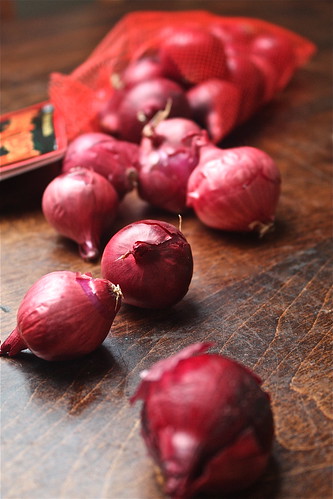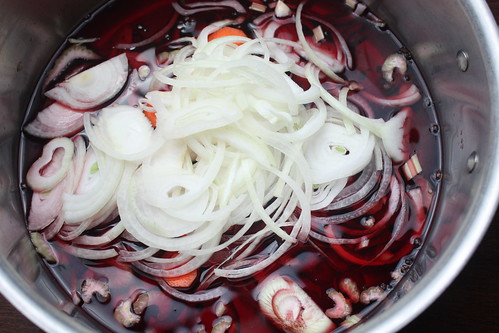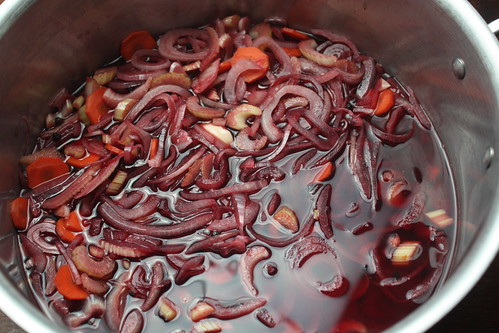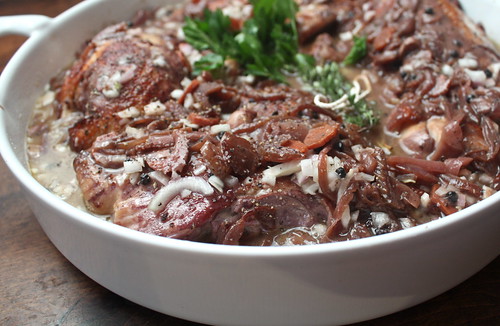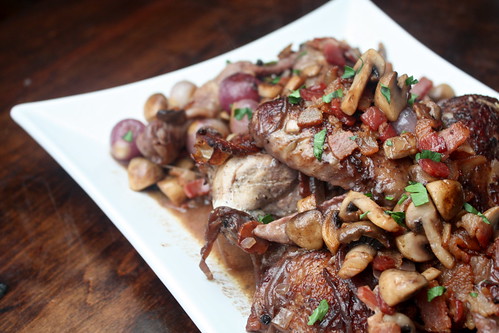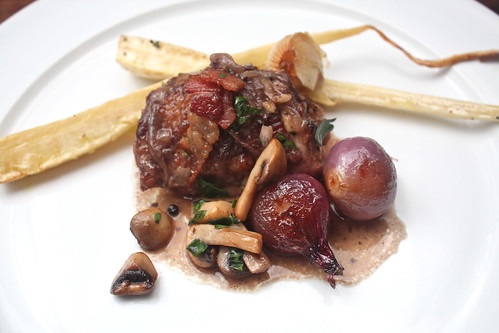Coq au Vin
I love cooking with wine. Although I do enjoy a dry white splashed into a pan of caramelized shallots for deglazing, or marsala stirred into a mixture of sauteed mushrooms and garlic before a bit of cream is added, I most enjoy meat or poultry braised slowly in red wine over the course of a Sunday afternoon. Anticipation builds as a heavenly aroma fills the house making us all a bit anxious for dinner time to arrive to see whether the finished product lives up to its promise.
Sometimes, I’m a fairly hard sell. It isn’t so much that the most recent recipe I’ve experimented with isn’t good; they very nearly always are. But think about it. Once you’ve had an amazing version of something you truly enjoy, it’s challenging for anything else to replicate the wonder of that first bite.
Mention Coq au Vin and someone will ask about what the special occasion might be. When you consider that any braise is done because the meat used is not an expensive cut, and needs to cook for a long time to make it tender, you know it isn’t necessarily a fancy dish. In the case of Coq au Vin, traditionally, the farmer’s old rooster became the dinner. Bacon, mushrooms, onions, and a liberal quantity of red wine made for quite the send off for that old rooster, and a savory treat for the farmer after a hard day’s work. All things considered, Coq au Vin is a one pot dish.
I’ve had my eye on a recipe for Coq au Vin I first saw in Saveur. The only reason I haven’t made it before now is that it required marinating the chicken overnight and sometimes my lack of planning gets the best of me. That oversight hasn’t kept me from making Coq au Vin because I just choose a different version. Unfortunately, that hasn’t solved the problem. I’ve wondered about how the marinade might change the complexity of the flavors and whether this particular recipe might be the one to best all of the others.
Evidently, I’m not the only one. It just so happens that it’s the source of the next recipe I’d like to try for Coq au Vin. Might it be the one? I’d have to actually find a rooster that doesn’t have his feathers on to get started…and deal with his kidneys.
Coq au Vin
3 cups red wine
1 tsp. whole black peppercorns
3 cloves garlic (1 whole, 2 chopped)
2 ribs celery, thinly sliced
1 medium carrot, thinly sliced
1 medium yellow onion, thinly sliced
1 5–6-lb. chicken, cut into 10 pieces
3 tbsp. olive oil
8 sprigs flat-leaf parsley plus 1 tbsp.
chopped leaves
2 bay leaves
2 sprigs thyme
1/2 lb. slab bacon, cut into 2″-long slivers
3 tbsp. flour
2 cups Chicken Stock
2 shallots, chopped
Kosher salt and freshly ground black pepper
4 tbsp. butter
18 pearl onions, peeled
1/2 lb. button mushrooms, quartered
The directions can be found here.
Notes:
- I used a whole, pre-cut chicken and included all but the gizzard, liver, and heart in this recipe. With respect to the bacon, I’ve never taken the time to find out where I can get slab bacon, so just use thick-cut bacon: about 10 strips because you can never really have too much bacon, can you?
- I chopped all the garlic and added it to the marinade. I’d like to say I did this purposefully, but that would not be the case. In any event, it was all going into the pot, so I decided it wasn’t a grievous error.
- I don’t make my own chicken stock. I consistently use “Better than Bouillon” bases for my cooking. They cost more, but are worth it when you’re making something nice.
- I used a small package of red pearl onions. To prepare them, drop them into softly boiling water and allow them to cook for a few minutes before pouring them into a strainer and dousing them with cold water until they’re cool. A bowl of water filled with ice cubes works just fine. To peel them, slice off the root end and the covers slide right off. This still takes patience, so don’t underestimate the time involved in this step unless you’re an Olympic pearl onion peeler. You might assign it to an unsuspecting person related to you who happens to live in your house. Train them early is what I always say.
- If I’m going to cook with wine, I don’t use anything I wouldn’t drink. It’s tempting to go with something less costly, but taste it and then you’ll know. You might be surprised at how great a $10 bottle of wine is. The chicken isn’t expensive, so splurge on the wine. I probably committed a faux pas by using a lovely Rioja Tempranillo from Espana. When you live in California, the French wine selection isn’t always that great (or you’re like me and don’t really understand what is good and what isn’t), and the Spanish selection is constantly improving. There’s no logic in that explanation beyond the parenthetical insertion, but I’m sticking with it.
- Leave the skin on. Resist the urge to take it off. You’ll have other opportunities to avoid it later. For example, peel it off after you’ve plated your portion. Or, if you make this ahead, and you can do that, after refrigerated, the excess fat is visible, and you can remove it before reheating it.
- This is a very good recipe. Very. If you’ve not made Coq au Vin, it’s a great place to begin.
- The three of us enjoyed this with roasted parsnips and had plenty left over for another meal.
- If you’d like to try Julia’s version, it can be found here.
- Or you can read about which version is better at Chowhound. That would be the throwdown between Julia and Molly.
Ready for the oven.
Ready to serve.
Done.
